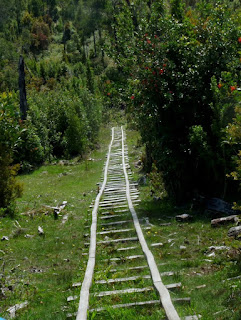The island of Chiloé lies off the coast of Chile, roughly a thousand kilometres south of Santiago. It is wild and wet (more than two metres of rain a year) and not really part of the tourist trail, but it is well worth spending time there. One of my favourite parts of the island is the Chepu district near the north-west coast, named for the Chepu River which flows through it.
 |
| Riverside forest along the Chepu River; behind the lower streamside forest is the distinctive taller Nothofagus (Antarctic Beech) which dominates the island's forests. |
 |
| The red arrow points to Chiloé, south of the port of Puerto Montt. |
 |
| Chiloé, with the arrow indicating the approximate location of Chepu. |
There are no state-run reserves in the immediate vicinity, but some local landholders have forest on their property and are willing to take people into it. One even boasts a little homemade 'railway' down the hill to the start of the forest!
 |
| Ingenious, but I'd not want to try it at any speed! |
Tracks have been cut through dense high stands of bamboo, 'quila' locally; Pudu (diminutive deer) and skulking Magellanic Tapaculos flit across the openings.
 |
| Quila towering over visitors. |
In the forest it is dark, with 'Spanish moss' and other epiphytes festooning the trunks, trying to get nearer to the light.
 |
| Bromeliad growing on Nothofagus trunk. |
 |
| A climber, the lovely Luzuriaga polyphylla, family Philesiaceae (or possibly now Alstroemeriaceae). The genus has a Gondwanan distribution, with three species in Patagonia and one in New Zealand. |
 |
| Rubus geoides, family Rubiaceae, grows in wet situations - not hard to find in Patagonia! |
Birds are hard to photograph in the dim light, but one bird stands out - the magnificent Magellanic Woodpecker is huge and its 'chopping' is unmistakable. Not for nothing is he known as 'el carpintero', the carpenter.
 |
| Male Magellanic Woodpecker Campephilus magellanicus; she has a black head. This one was near the farmhouse. |
 |
| Unidentified, but very impressive, cryptic grasshopper. |
 |
| Painted Tree 'Iguana' (though it's not really!) Liolaemus pictus, making the most of the facilities of the farm's greenhouse. |
At the mouth of the Chepu, conditions are very different. The beach is accessed by a very steep rough track at the end of the road, and the Pacific winds seem rarely to sleep.
 |
| The huge-leaved of Gunnera tinctoria - more usually associated with wet banks - seems quite at home in the sand. |
Which brings us to the river, my personal highlight of a visit to Chepu. Boat trips are available from local fishing people, though you don't want to spend too much time trying to decipher the sign...
 |
| The Spanish at least is unambiguous - it just says 'boat trips'! |
Somewhat more of a shock however is the sight of dead trees stretching across the valley.
 |
| The tsunami came right up the valley, drowning the forest in seawater. |
From the river however, the damage becomes less evident as we head upstream.
 |
 |
| Ringed Kingfisher Megaceryle torquata, always an exciting bird to see, not least because of its size (40cm). It is found from the southern tip of South America to the Mexico-US border. |
One of the features of the trip is watching for Coypu Myocastor coypus, a big semi-aquatic rodent (the only member of its family) which is native to this part of the world, but has been widely introduced elsewhere by the fur trade, usually to the detriment of the local environment. In many other places it is known at Nutria, but this is Spanish for otter, so is very confusing!
Eventually the river opens out into the lovely Lago Coluco, which has resident pairs of the very handsome Great Grebe Podiceps major.
 |
| The Great Grebe wears its title with justification; at up to 80cm long it is the world's largest grebe. |
The star bird attractions on the lake however are the Brown-hooded Gulls Chroicocephalus maculipennis, which breed here in huge numbers in the reeds.
 |
| A small part of Lago Coluco's Brown-hooded Gull colony. This gull is found only in southern South America. |
 |
| Brown-hooded Gull nest; the nest is floating, but held in place by the reeds. |
They really are a most attractive gull, on water, land or air.
 |
| With Coypu. |
Chepu is not likely to be the highlight of any trip to South America, but I'd expect that, like me, you'll remember it fondly long afterwards.
BACK ON THURSDAY
(And remember that you can get a reminder when the next post appears by putting your email address in the Follow by Email box in the top right of this screen.)
(And remember that you can get a reminder when the next post appears by putting your email address in the Follow by Email box in the top right of this screen.)







Coypu. Hurrumph! Here in France they get trapped and bopped on the head as they are declared a pest species. Sometimes they get turned into terrine de lièvre des marais.
ReplyDeleteYes, but hardly their fault! I'm sure they'd much prefer to have been left in South America... (How does swamp hare terrine taste, by the way?)
ReplyDelete